

*****
A Discovery in 1970
In June 1970 the literary world was rocked with news that a previously unknown Mark Twain manuscript had been discovered and recently sold to the New York Public Library. A press release by George Gent of The New York Times spread quickly in major U.S. newspapers from coast to coast. The manuscript, written by Samuel Clemens between May and September 1909, was soon referred to as the "Ashcroft-Lyon Manuscript." In it Samuel Clemens told how his former trusted associates Ralph Ashcroft and Isabel Lyon had forged his signature to business documents including a Power of Attorney giving themselves complete control over his affairs; swindled and cheated him; and manipulated newspaper reports to make themselves look innocent.
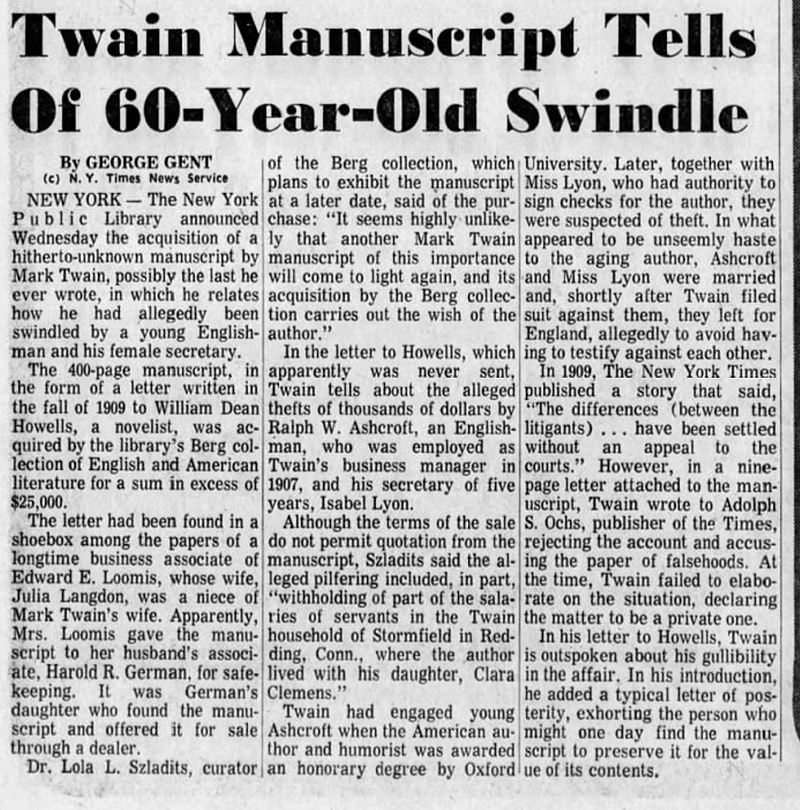 "
"
Clipping from Allentown, Pennsylvania MORNING CALL, June 25, 1970, p. 16
is typical of the stories carried by newspapers across the U.S.
Legal ownership of the newly discovered "Ashcroft-Lyon Manuscript" was challenged by heirs of Samuel Clemens's wife Olivia Langdon Clemens and the sale to the New York Public Library was invalidated. In March 1973 the manuscript was awarded to the Mark Twain Papers at the University of California at Berkeley. Hamlin Hill was the first Mark Twain biographer to utilize information contained in the "Ashcroft-Lyon Manuscript" in his book Mark Twain: God's Fool (1973). Subsequent biographies that drew substantially on the document were Karen Lystra's Dangerous Intimacy: The Untold Story of Mark Twain's Final Years (2004); Laura Skandera-Trombley's Mark Twain's Other Woman (2010); and Michael Shelden's Mark Twain, Man in White: The Grand Adventures of His Final Years (2010). Each biographer analyzed the validity of Clemens's accusations with differing conclusions.
In 2015 the entire text of the manuscript was published as an Appendix in Autobiography of Mark Twain, Vol. 3 by the University of California Press.
*****
Flashback to 1966
Four years before the discovery of the "Ashcroft-Lyon Manuscript" -- on November 3, 1966 a group of fifteen items listed in the Charles Hamilton Auction Catalog #15, as Lot 281 on pages 79 and 80 were quietly and without fanfare purchased by the Carnegie Book Shop of New York on behalf of the Friends of Detroit Public Library for their Rare Book Collection. The auction description was for a "Magnificent, important collection." Although it was not stated in the auction description, the items had belonged to Ralph W. Ashcroft, Clemens's former business associate, who had died in 1947. Hamilton's auction catalogs were issued in an unpretentious format and bound together by plastic comb bindings, much like an inexpensive cookbook. Today few copies survive.
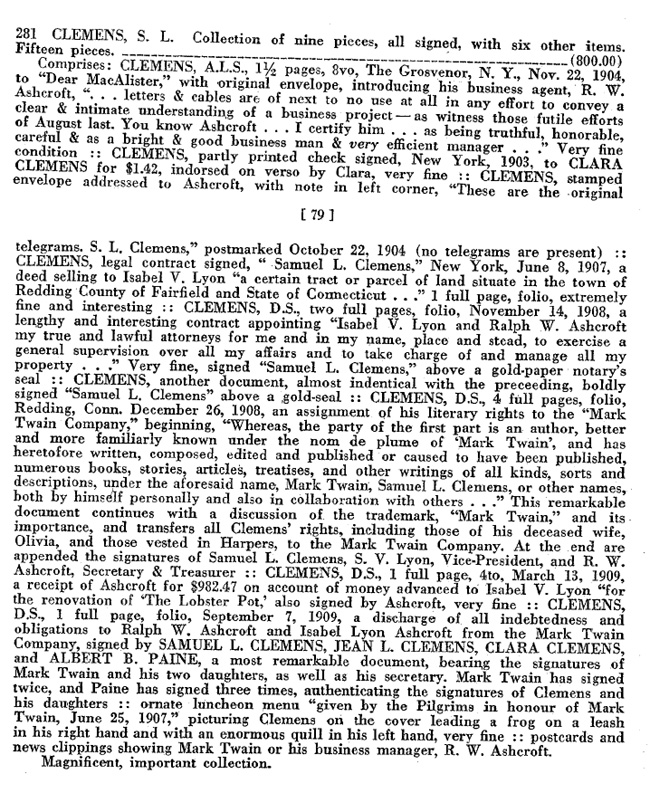
Charles Hamilton Auction Catalog #15, Lot 281, November 3, 1966, pages 79
and 80
*****
Lost or Stolen
In June 2004 I wrote a book review for the Mark Twain Forum of Karen Lystra's new biography Dangerous Intimacy. Lystra's book chronicled the troubled relationship between Samuel Clemens and his former secretary Isabel Lyon who had married Ralph Ashcroft. While writing that review and comparing it to Hamlin Hill's God's Fool, I found that Hill had included references to the Charles Hamilton auction catalog dscribing the Ashcroft materials. I questioned how Lystra could substantiate accusations of forgery against Ashcroft and Lyon without examining the actual papers formerly owned by Ashcroft that were held by Detroit Public Library.
A number of years went by after my book review was published online and in September 2010, the late Lawrence "Larry" Berkove of Detroit, emailed me that he had gone to the Detroit Public Library to examine the Ashcroft documents. They were gone. He and the library staff were stunned. After a diligent search of several months, in June 2011 Mark Bowden, Coordinator for Special Collections of Detroit Public Library confirmed that eleven items from the original Charles Hamilton catalog lot were missing and presumed lost or stolen.
After over a decade of quietly watching internet sales of Mark Twain memorabilia as well as prestigious auction house sales and hoping the missing Ashcroft items would resurface, the documents still have not been found as of October 2021.
*****
What Remains and the Significance of What is Missing
Below are individual descriptions of each item from the auction catalog along with editorial comments related to their importance to Mark Twain studies today. Missing items are indicated with the heading *****MISSING*****.
~~~~~
Item #1 - CLEMENS, A. L. S. 1 1/2 PAGES, 8vo. Written from the Grosvenor, N.Y., Nov.22, 1904 to J. W. Y. MacAlister "Dear MacAlister," with original envelope, introducing his business agent, R. W. Ashcroft "as being truthful, honorable, careful & as a bright & good business man & very efficient manager…" Very fine condition.
Comments: This item has been accounted for in the Detroit Public Library.
~~~~~
Item #2 - Partially printed signed check by Clemens to Clara Clemens. New York 1903. For $1.42. Endorsed on back by Clara Clemens. Very fine condition.
Comments: This item has been accounted for in the Detroit Public Library. Why Ashcroft retained a check for such a minor amount featuring the signatures of both Clemens and his daughter Clara is a mystery.
~~~~~
Item #3 - Empty stamped envelope addressed to Ralph Ashcroft with notation in Clemens's hand in "These are the original telegrams. S.L.C" postmarked October 22, 1904. No telegrams are present.
Comments: This item has been accounted for in the Detroit Public Library. According to Dr. Robert Hirst, General Editor of the Mark Twain Papers (MTP) at the Univesity of California at Berkeley, the brief note on the envelope mentioned in the Hamilton catalog was actually 24 October, not 22 October, 1904. The Detroit Public Library sent MTP a copy in 1980. (Personal correspondence from Hirst, June 15, 2004.)
~~~~~
*****MISSING*****
Item #4 - Legal contract signed by Samuel L. Clemens, New York, June 8, 1907, a deed selling to Isabel V. Lyon "a certain tract or parcel of land situated in the town of Redding County of Fairfield and State of Connecticut …" 1 full page, folio, extremely fine and interesting.
Comments: Karen Lystra in DANGEROUS INTIMACY (University of California Press, 2004), writes:
"In the flurry of paper shuffling that fall and early winter of 1908, two signatures requested by Ashcroft stuck in Clemens's mind. In the first instance the business manager asked Clemens to sign a duplicate deed to the property he had given Miss Lyon in 1907. This was required Ashcroft told his boss, because she had failed to record the original deed. Clemens remembered that after he had perused the document, Ashcroft turned away, carried it to the table, rearranged the papers on the table, and called him to sign, which he did without reexamining the document. (40) He discovered later that the original deed had, in fact, been recorded and was completely legal. Did Samuel Clemens simply sign a superfluous property deed that day or was a switch made at the last minute?" (Lystra, p. 157).
Lystra, in her reference note (40) cites the "Ashcroft-Lyon Manuscript," pp. 223-228.
~~~~~
*****MISSING*****
Item #5 - Samuel Clemens signed document. Two full pages, folio, November 14, 1908 appointing "Isabel V. Lyon and Ralph W. Ashcroft my true and lawful attorneys for me and in my name, place and stead, to exercise a general supervision over all my affairs and to take charge of and manage all my property …" Very fine, signed "Samuel L. Clemens" above a gold-paper notary's seal.
~~~~~~
*****MISSING*****
Item #6 - Another document almost identical to Item #5 signed by Clemens above a gold seal.
Comments: Items #5 and #6 are described as "almost identical." But what was the difference? Whether or not subterfuge was used to obtain the November 14, 1908 Power of Attorney is one of the most controversial topics in Mark Twain studies.
A carbon copy of the Power of Attorney is in the Mark Twain Papers. In the "Ashcroft-Lyon Manuscript:" Clemens attached both his copy of the Revocation of the Power of Attorney and the carbon copy of the original Power of Attorney and labeled it "Exhibit A." Harriet Smith, an editor at the MTP, explained in correspondence June 10, 2015:
"The entire document that is part of the A-L MS--that is, the revocation of the P of A and the text of the P of A [Exhibit A]--is a carbon copy. It has page numbers on it in SLC's hand that are part of the MS page sequence. The revocation document is a typed carbon, signed in ink. Exhibit A is a typed copy only, with no seal or original ink signatures. In other words, we have no original of the P of A document, nor do we at this point know the location of any originals, since the ones in the Detroit Public Library have disappeared" (Smith, June 10, 2015).
Hamlin Hill in God's Fool (Harper & Row, 1973) states:
"However murky his recollection of signing the document (and he was to insist for some time that the signature was a forgery), his sober evaluation of its power was correct" (Hill, p. 212). "It was comprehensive. And Clemens did indisputably sign it" (Hill, p. 213).
Hill also quotes a letter from Clemens to William R. Coe written on June 16, 1909 after he had discovered the existence of the Power of Attorney and revoked it on June 1, 1909. Clemens called it:
"the most amazing document that has seen the light since the Middle Ages. It bears date Nov. 14 last, and is a General Power of Attorney which hands me and all I own and all I ever shall own over to Ashcroft and Miss Lyon. Until June 1 I had never heard of that paper--yet I signed it" (Hill, p. 212).
Hill further concedes:
"Possibly, as he claimed, the signatures were obtained and notarized by fraud; more likely, they were placed on documents when he was so befuddled and indifferent that he could confuse his own ennui with 'hypnosis.' Many years later, when she was in her seventies, Isabel would claim 'that she soon discovered that she had taken a viper unto her bosom; that her new husband … proved to be a forger and all-around crook for whose actions she was equally blamed" (Hill, p. 241, quoting "Report of Miss X," DeVoto Papers, Stanford University, photocopy in MTP).
Laura Skandera-Trombley in Mark Twain's Other Woman aligns her theory with Hamlin Hill but goes further to vindicate Ashcroft by stating:
"Twain asked that a new legal document be drawn up …" (Trombley, p. 190).
However, Trombley offers no proof it was Twain's idea to construct a comprehensive Power of Attorney for Ashcroft and Lyon. Trombley's major argument is that since the document was notarized by John Nickerson, it was an authentic signature.
Karen Lystra in Dangerous Intimacy states regarding the notary:
"John Nickerson, the local Redding notary, routinely certified Clemens's signature on documents without requiring the famous author to appear in person" (Lystra, p. 158).
Lystra also relates how word about the existence of such a Power of Attorney got back to Clemens via Albert Bigelow Paine who was provided the information by Harry M. Lounsbury (1895-1919), a teenage son of Clemens's estate manager Harry A. Lounsbury (1873-1938). Lystra recounts how Paine and Clara Clemens visited notary Nickerson who told them he recalled certifying Clemens's signature (p. 186-187). Lystra quotes Clemens's statement:
"These people had not asked me for a power of attorney and I had not conferred one upon them. The subject had never been mentioned" (Lystra, p 187 quoting from the "Ashcroft-Lyon Manuscript").
Michael Sheldon in Mark Twain: Man in White (Random House, 2010) states that John Nickerson notarized the document without Clemens being present and writes:
"Ashcroft had had this fraudulent document placed on record in New York, just as if it had been a deed" (Sheldon, p. 293 quoting from the "Ashcroft-Lyon Manuscript").
Lystra and Sheldon's theories that the Power of Attorney was notorized outside of Clemens's presence are supported by the eyewitness account of John Nickerson's daughter Helen Nickerson Upson that was published in The Redding Times, June 2, 1960 indicating she was present when Clemens told her father he had signed the document without any explanation of what he had signed. This story was accessed 5/23/2013 online at: http://twainproject.blogspot.com/2009/11/new-stormfield-articles.html
No forensic examination has been reported regarding the two copies of this document that were once in the Detroit Public Library. Were the signatures genuine? Was either one or both identical in content to the carbon copy now held by the Mark Twain Papers?
~~~~~
*****MISSING*****
Item #7 - Signed document by Clemens. 4 full pages, folio, Redding, Connecticut, December 26, 1908, an assignment of his literary rights to the "Mark Twain Company," beginning, "Whereas, the party of the first part is an author, better and more familiarly known under the nom de plume of 'Mark Twain', and had heretofore written, composed, edited and published or caused to have been published, numerous books, stories, articles, treatises, and other writings of all kinds, sorts and descriptions, under the aforesaid name, Mark Twain, Samuel L. Clemens, or other names, both by himself personally and also in collaboration with others …" Continues with a discussion of the trademark, "Mark Twain," and its importance, and transfers all Clemens's rights, including those of his deceased wife, Olivia, and those vested in Harpers, to the Mark Twain Company. At the end are appended signatures of Samuel L. Clemens, I. V. Lyon, Vice-President, and R. W. Ashcroft, Secretary & Treasurer.
Comment: Hill, in God's Fool states the organizational papers for the Mark Twain Company were filed on December 22, 1908 and were drawn up by attorney Mansfield Hobbs. Hill further states, citing only the Charles Hamilton auction catalog description of the document, that
"Clemens executed a document on the incorporation of the company, assigning and transferring all his literary rights to it" (Hill, p. 212).
Hill is the only biographer to utilize the Charles Hamilton auction catalog in his citations.
~~~~~
Item #8 - Signed document by Clemens. 1 full page, 4to, March 13, 1909, a receipt of Ashcroft for $982.47 for money advanced to Isabel V. Lyon for renovation of her home "The Lobster Pot." Also signed by Ashcroft. Very fine condition.
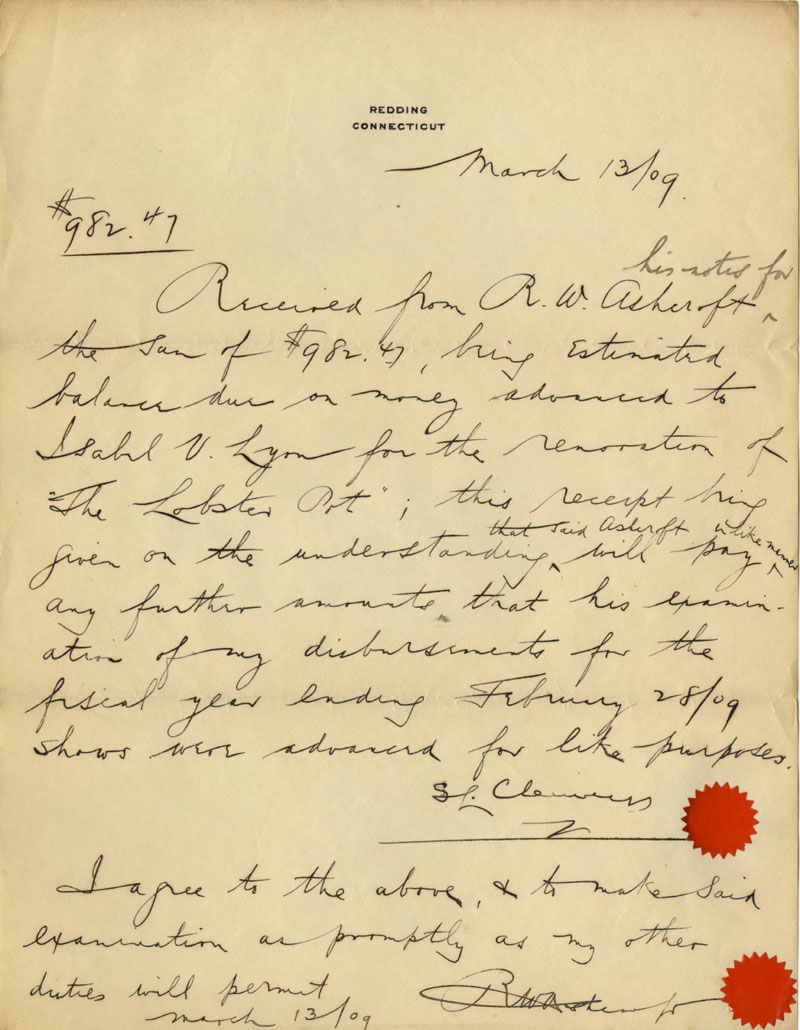
Image courtesy of the Detroit Public Library
Comment: Of all the documents crucial to the charges of forgery and malfeasance on the part of Ashcroft, this one still remained in the Detroit Public Library in 2010.
On August 4, 1909, newspapers across the country reported on an ongoing feud between Ashcroft and the Clemens family with Ashcroft providing documents to the press which included the text of the above document. The New York Times ran a front page story with Ashcroft launching accusations of jealousy against Clara Clemens. Ashcroft provided to the press a copy of the above receipt defending himself against any fiscal wrongdoing and stating "no one can sue for a debt which has been partially paid and the balance of which is not due" (The New York Times, August 4, 1909, p. 1).
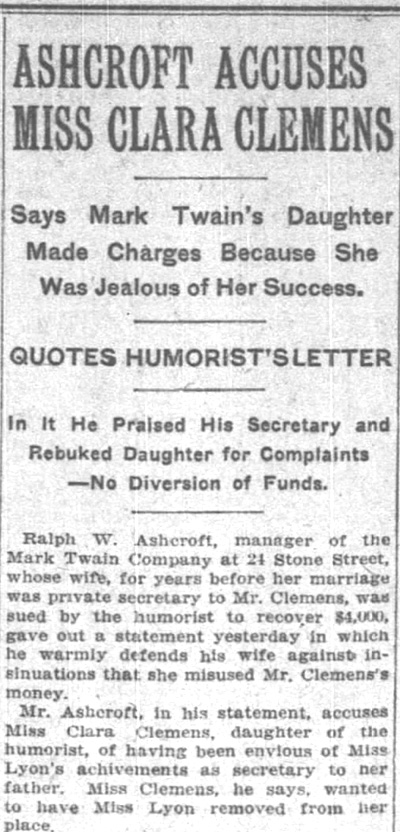
Headlines and first two paragraphs from Ashcroft's front page story in THE
NEW YORK TIMES, August 4, 1909.
The entire story ran for a full column and continued on page 2.
Full text of this story available at: http://www.twainquotes.com/19090804.html
Karen Lystra in Dangerous Intimacy has described the document as a damning invention and "a phony legal document" (Lystra, p. 213) fabricated by Ralph Ashcroft. Lystra quotes Clemens as writing:
"I hope I may land in perdition before I finish this sentence if I ever heard of that piece of writing until I saw it in that interview in the Times" (Lystra, p. 211, quoting from the "Ashcroft-Lyon Manuscript").
According to Robert Hirst, General Editor of the Mark Twain Papers based on examination of a photocopy held in the Mark Twain Papers, this document is all in Ashcroft's hand except the signature by Clemens.
"The Xerox we have of it does suggest to me that it could easily have been signed by Clemens before the top was filled in (it is handwritten, and a line is provided for him to sign on--not something that would be necessary if he were simply to sign following the text). (Robert Hirst, personal correspondence June 15, 2004).
~~~~~
*****MISSING*****
Item #9 - Signed document. 1 full page, folio, dated September 7, 1909,
a discharge of all indebtedness and obligations to Ralph W. Ashcroft and Isabel
Lyon Ashcroft from the Mark Twain Company, signed by Samuel L. Clemens, Jean
L. Clemens, Clara Clemens, and Albert B. Paine. According to the Charles Hamilton
catalog description, "Mark Twain has signed twice, and Paine has signed
three times, authenticating the signatures of Clemens and his daughters."
Comment: The Detroit Public Library files contain a description of this item:
Document: 1909 Sept. 7, Redding Conn. 1 p. 32cm. Typescript signed by Samuel L. Clemens, Jean L. Clemens, Clara Clemens, Albert B. Paine and notarized by Harry A. Lounsbury. Contains the seal of the Mark Twain Company. General Release of all debts, dues, damages, etc., to Ralph W. Ashcroft and Isabel Lyon Ashcroft from Samuel L. Clemens, Clara L. Clemens, Jean L. Clemens and Mark Twain Company. Gift from Friends of Detroit Public Library. Purchased at Hamilton sale 15, Nov. 3, 1966, part of lot 281.
No photocopies of this discharge of indebtedness are known to exist. What is problematical is that the Detroit description identifies Harry A. Lounsbury as notarizing the document. Lounsbury is not known to have held a notary's certification.
Four days after this document was signed, a small newspaper the Bridgeport Evening Farmer, broke the story in their Saturday, September 11, 1909 issue with a number of inaccuracies including the references to Clara Clemens as "Clara Twain." The article stated the Ashcrofts were in possession of "a piece of paper that the Ashcrofts prize most highly." The Evening Farmer would issue one major correction a few days later.
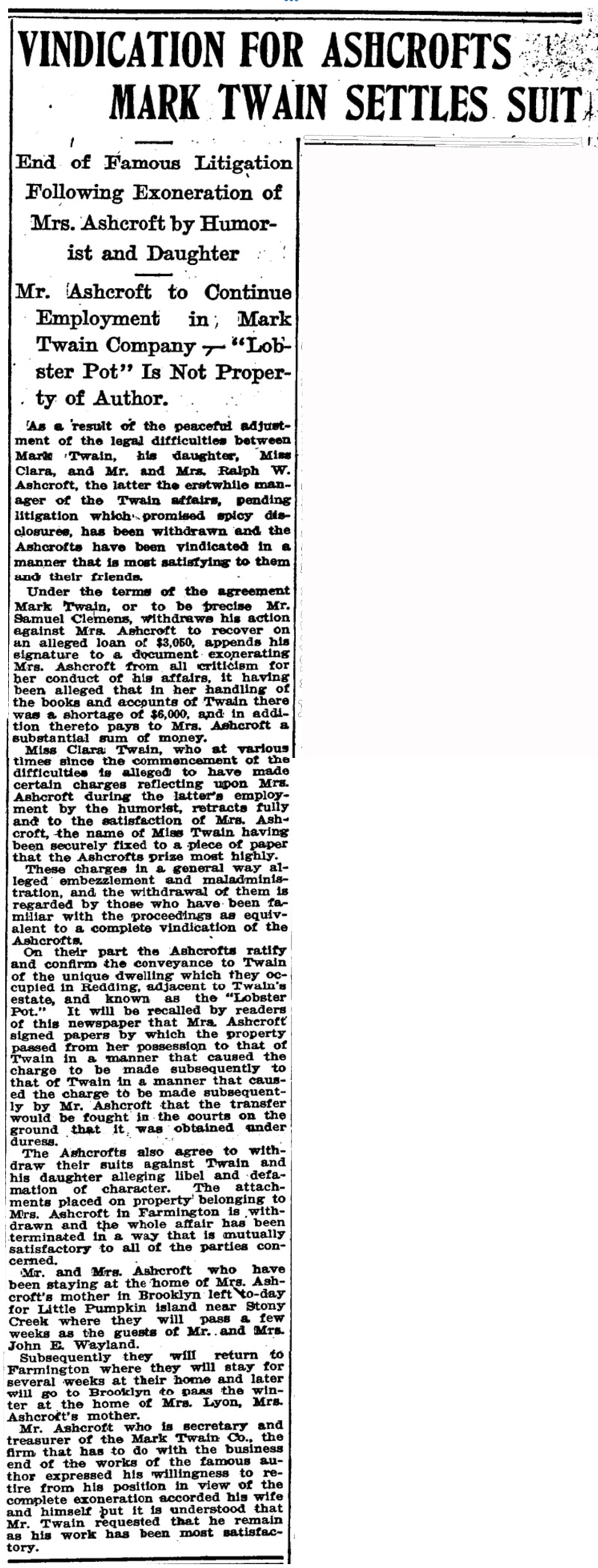
Clipping from front page of BRIDGEPORT EVENING FARMER, Saturday, September
11, 1909.
The next day other U.S. newspapers from coast to coast featured similar stories in their Sunday issues with a dateline of Bridgeport, Connecticut, September 11.
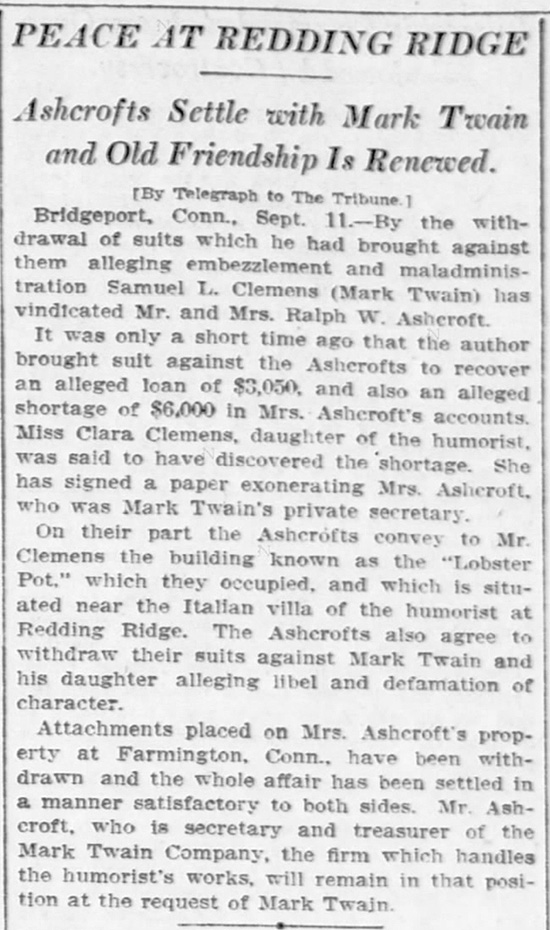
This story appeared on the front page of the NEW YORK TRIBUNE on Sunday, September 12, 1909.
The following day, Monday, September 13, 1909 The New York Times ran a similar story buried on page 8.
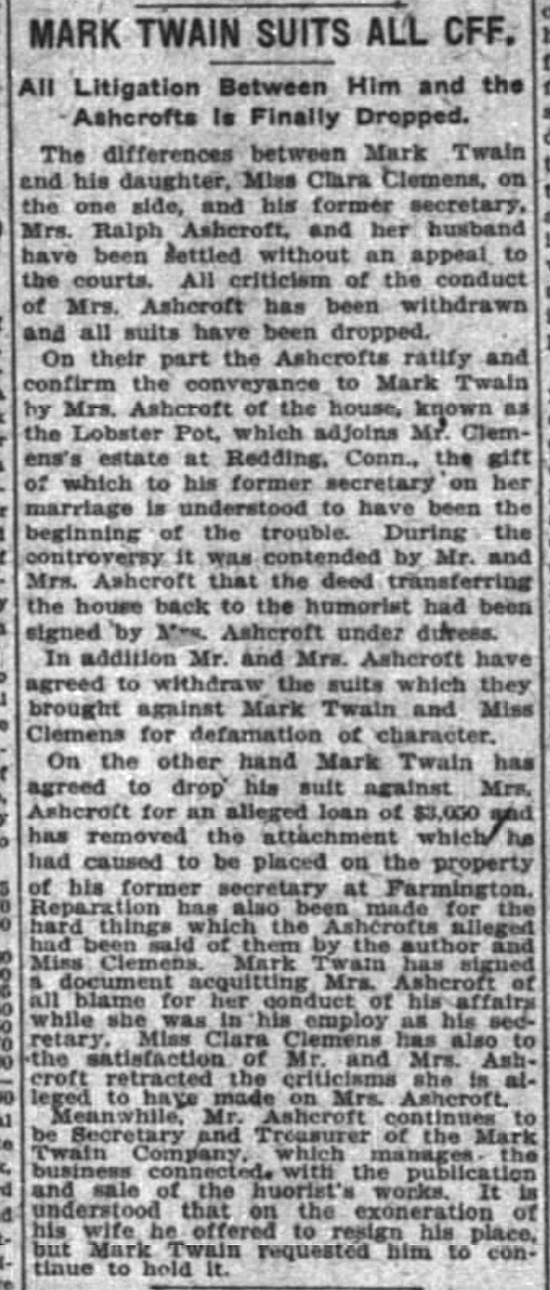
THE NEW YORK TIMES, Monday, September 13, 1909, p. 8
_____
Hamlin Hill in God's Fool cites the existence of the discharge of obligations
document referring to the Charles Hamilton Auction catalog description (p. 239
and note on p. 294). Hill discusses Clemens's reaction to the story quoting
from a draft of a letter of rebuttal written to Melville Stone of the Associated
Press the following day:
"Clara wants it in the Associated Press, but if I alone were concerned I wouldn't take any notice of the rotten Ashcrofts" (Hill, p. 240 quoting from Clemens to Stone, September 14, 1909).
No rebuttal by Clemens to the Ashcroft story has been found in the subsequent newspapers.
Laura Skandera-Trombley in Mark Twain's Other Woman (p. 222-223) discusses the discharge of obligations agreement as reported in The New York Times and the fact that the Times article enraged Clemens who composed a letter that same day September 13, 1909 (he apparently did not send it) to Adolph S. Ochs, publisher and owner of the Times. Quoting Clemens:
"None of the interview was up to the standard of matter fit to print in The Times without examination as to their truthfulness…the sub-editor who accepted the interviews without verification of their alleged facts had also a personal grudge against me" (Trombley, pp. 222-223, quoting from the letter filed at MTP with the "Ashcroft-Lyon Manuscript").
Karen Lystra in Dangerous Intimacy discusses The New York Times report (p. 214-215) stating:
"the Times even had Twain sign a non-existence document" (Lystra, p. 214). "Twain never signed any document acquitting Mrs. Ashcroft" (Lystra, p. 215).
Lystra characterizes the news reports as an astonishing set of lies and points to the fact that:
"Clemens and his new board of directors had formally asked Ashcroft to resign on September 11, which he did" (Lystra, p. 215 referencing the "Ashcroft-Lyon Manuscript").
Michael Sheldon in Mark Twain: Man in White simply states:
"Ashcroft gave a false story to the Times" (Sheldon, p. 465, note 53).
Without seeing the original of this document, Robert Hirst is of the opinion:
"that quit claim doesn't look to me like evidence of a loan, or a debt. It's an attempt to foreclose any future action should any such seem tempting to Clemens. 'General Release of all debts, dues, damages, etc., to etc.' from signatories for the Mark Twain Company (therefore I assume not relevant to any personal loan or nonloan).
Hirst further concludes that the document
"was not evidence for a loan, a suit to recover a loan, or a decision to drop said suit. This does seem to me Ashcroft quite brilliantly playing the press" (Hirst, personal correspondence June 15, 2004).
A semi-retraction or correction was published in the Bridgeport Evening Farmer the following Thursday, September 16, 1909. In the correction Ashcroft concedes he had never actually instituted a suit against Clemens or his daughter Clara for defamation. However, Ashcroft took the retraction as another opportunity to provide a copy of a letter to the press that he sent to Clemens's attorney asking for a letter of apology from Clemens be worded and contain the text he provided.
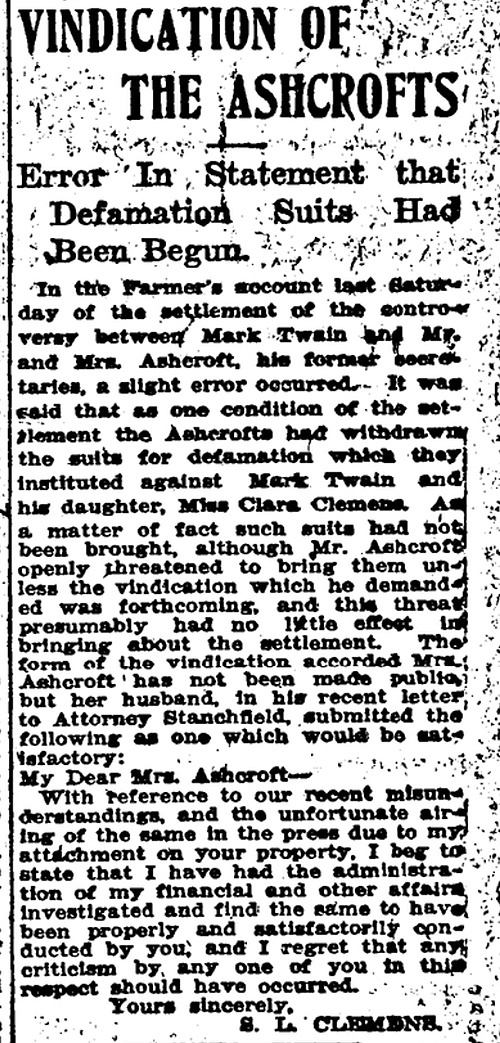
BRIDGEPORT EVENING FARMER, Thursday, September 16, 1909, p. 4.
Without access to the document signed September 7, 1909 and examination of it for specific wording, the extent of Ralph Ashcroft's manipulation of publicity surrounding it may never be truly established. It thus remains one of the most important of all the missing documents from the Detroit Public Library. To see the signatures and what those documents tell us about what actually happened, not to mention what they tell us about how Ashcroft and Clemens shaped publicity to their own ends is a lost opportunity to Mark Twain biographers.
~~~~~
*****MISSING*****
Item #10 - Ornate luncheon menu "given by the Pilgrims in honour of Mark Twain, June 25, 1907," picturing Clemens on the cover leading a frog on a leash in his right hand and with an enormous quill in his left hand, very fine.
Comments: Robert Rodney in Mark Twain Overseas (Three Continents Press, 1993) describes this menu as featuring "sketches of their guest of honor in Pilgrim's garb holding a quill pen as a staff (Rodney, p. 263).
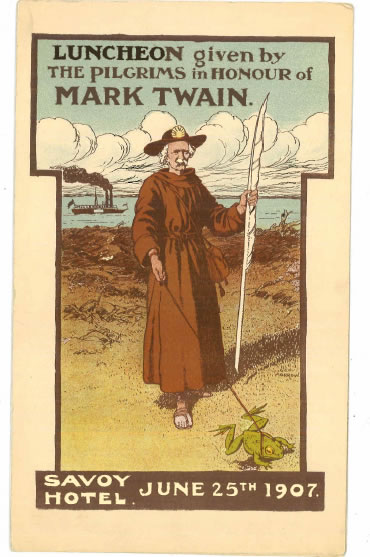
This menu is from the University of Chicago and like the one missing from the Detroit Public Library.
~~~~~
*****MISSING*****
Items 11 - 15 - postcards and news clippings showing Mark Twain or his business manager, R. W. Ashcroft.
~~~~~
The headlines regarding the Ashcroft-Lyon debacle faded in late 1909. Clemens wrote the "Ashcroft-Lyon Manuscript" to speak for him from the grave and as a weapon to be used in the press by his daughter Clara Clemens should she ever need that leverage. After Clemens's death in April 1910, Clara threatened Ashcroft and Lyon with publication of the manuscript if they did not return some of her father's stolen manuscripts they were caught trying to sell. The threat of publiction worked and the stolen manuscripts were returned to Clara. Ashcroft and Lyon later relocated to Canada where Ashcroft engaged in advertising for various Canadian business firms. He and Lyon divorced in 1926. Ashcroft's papers, now missing from the Detroit Public Library, leave the extent of his possible guilt or innocence untold.
